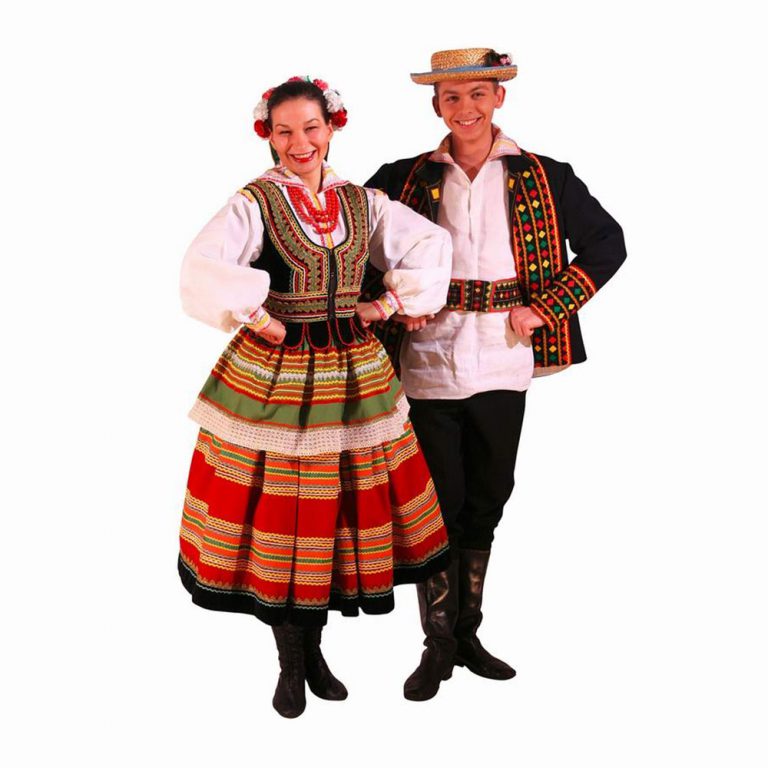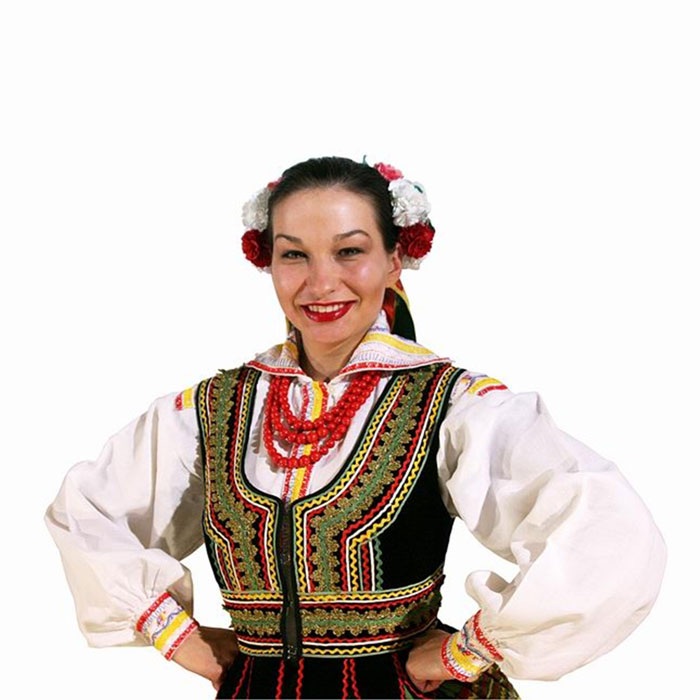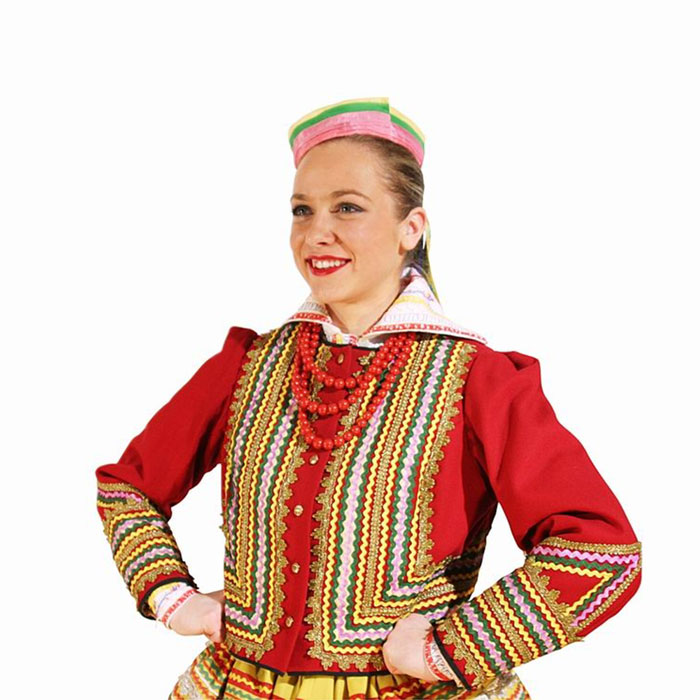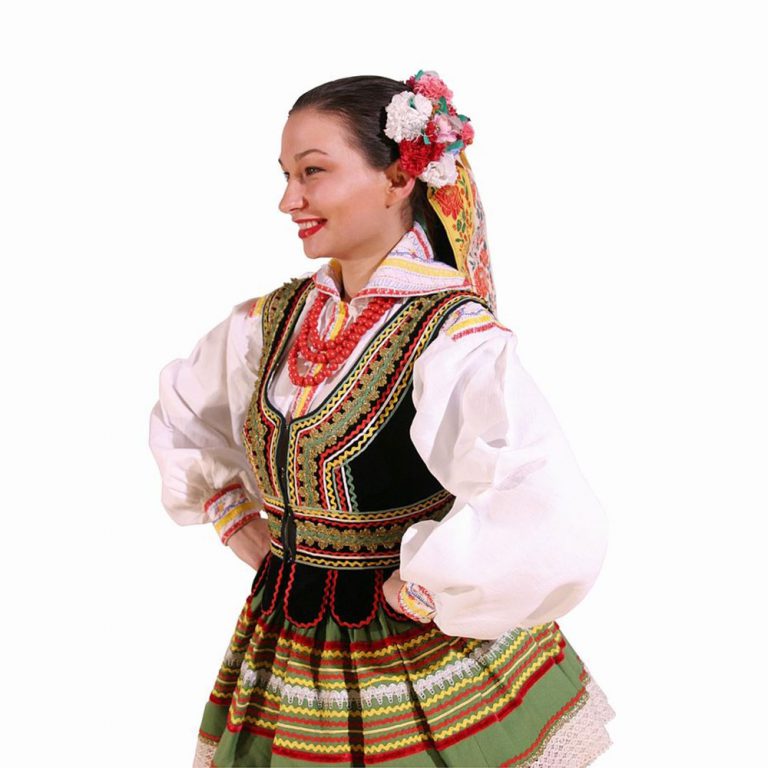Traditional costume from the Krzczonów region

From the large collection of outfits from region of Wisła and Bug ramification one differs very intensively – the krzczonowski outfit. The center of growth of this outfit is contained in Piotrków and KRzczonów and that’s why it is sometimes called “pietrzkowski”. The region where this outfit was worn was a ground of kings so that’s why people had there better conditions than the rest of country. The second thing is that this outfit was worn only by people from 30 villages from one parish. Krzczonów was the residence of parish and it was a center of a local cultural and social life. Such conditions caused that outfit from Krzczonów started to be a representative outfit of Lubelszczyzna.
Women outfit
Formerly maids put their hair into braid with flowers and bandanas and in the end they put a bow. In the end of XIX century maids used to put hair into a form of half-moon. The decoration was made of flowers and stripes. The characteristic headgear of maids was humełka. It was a piece of white material or lace put into a rim. It was decorated with stripes and in the back it had silver threads. Married women used to wear bandanas called “dupka”. Womens shirts were sewn from linen materials, later from cotton one. Shirts had wide collar tied down with red or green stripe and it had wide long sleeves. The embroidery from Krzczonów was always assigned to stripes parallelly to the decorated part. Womens shirts had their embroidery on the collar, sleeves. In this embroidery dominates white with red blue and yellow. In the last period of growth people started to decorate the outfit with cross embroidery. The corsets appeared in 1870. They were made of black welur and they were tied with red and green stripe. The front of corset was decorated with squeezed green and red stripes. On the turning point of XIX and XX century corsets were decorated with gold and silver embroidery, silver and gold threads and sequins. On the shirts women put kaftans. First they were white later red, green made of thin wool. They were decorated with stripes which were assigned to groups of patterns. Initially skirts were made of linen material later in the second half of XIX century popular were skirts made of clear, mat woolen materials. Most of them were in blue, red and green tonation. They were long and they were buttoned in the front. They were sewn from 5 pieces of material. On the skirt, women put stripes in number 10 to 18. With a skirt women wore short but wide (2-2,5 m) zapaski. They were queezed on all their long. They were often sewn from different material than the skirt. Women wore high shoes with high heel.
Men outfit
The characteristic mens headgear was straw hat with black or navy blue stripe around the head. Bachelors also put on the left side of the hat small boquete of flowers, the peacocks feather and an emblem. The oldest people mentioned also about rogatywki, magierki and fur caps. Men put their shirt outside the trousers. They had simple sleeves and a collar. They were sewn from white linen material, and they were decorated with white embroidery later with colourful one. In 20s there came a fashion for a cross embroidery. Embroideries were put on the chest, collar, sleeves and in the lower part of shirt. First men wore linen trousers, in colder days white woolen one. From 1870 men started to wear trousers made of black material. Those trousers were decorated with red or green stripe on the trousers-legs. Trousers were tied with a leather belt. Kaftans appeared in the end of XIX century. They were made of black material, they were waist-long and had simple front and back. Kaftans had a 2 part collar with small flaps and cut sleeves. In the beginning of XX century appeared new style of decoration. People started to make holes and under them they put yellow, red and green stripes. Very important was a coat worn only for holidays. It was an obvious element of bridegrooms outfit. After First World War men started to wear wider belts (9-12cm). They were decorated with small holes or stripes and with small beads. From the begining of XX century popular were high-shoes with 6-8 part “harmonica” near heel.












